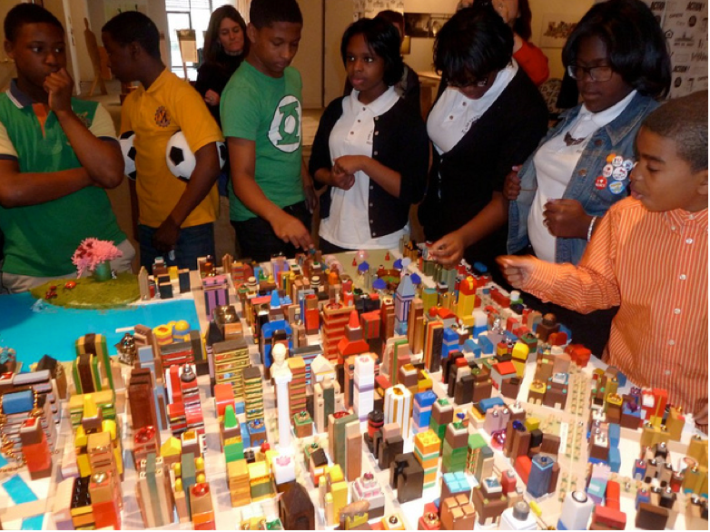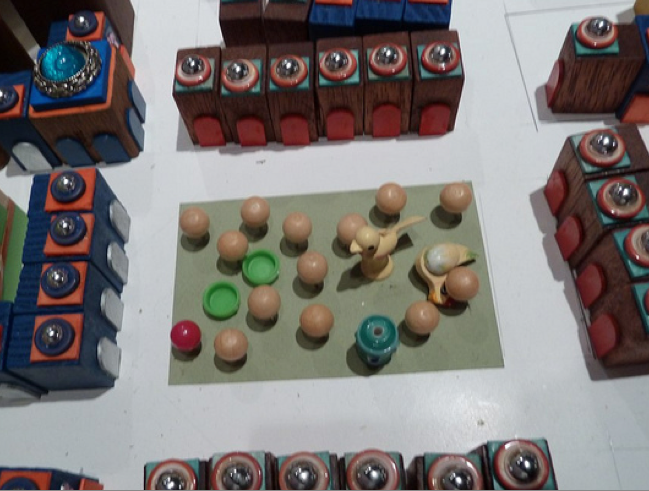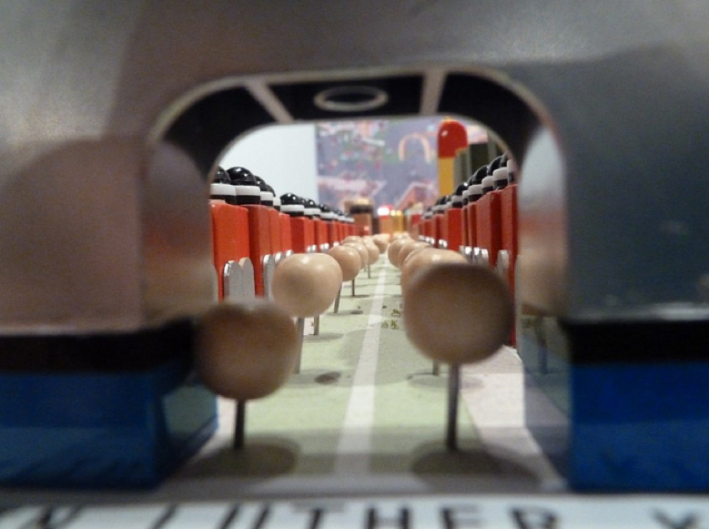
(Note: This is the second installment in our four-year series about how Baltimore, Maryland. Our first installment, "Baltimore Getting Serious About Bikes" appeared in May, 2008. - DN)
The Baltimore Interactive model is a thought provoking; birds eye view of this city. The model is designed for the participant to ponder, explore, and participate in creating a vision for this city by moving objects around it.
The six feet by six feet large model captures the city's majestic rolling hills, and it's European urban form of small street blocks, narrow streets, and intimate squares adorned with monuments. The five hundred small structures placed on the model add life to the map by adding a third dimension. Like a painting the model illustrates the city's the beauty and charm in a creative, and graphic presentation.
The model is a condensed version of Baltimore's center core that begins with Federal Hill to the south and ends at North Avenue to the north. From the east the model begins at Martin Luther King Street and to the west it ends with Little Italy and Greenmont Cemetery.
To facilitate quick recognition of Baltimore the major streets, landmarks such as the Howard Street light rail, Lexington Market, North Avenue Market, Camden Yards, and Penn Station were added and labeled along with geographical features such as the Inner Harbor and Federal Hill which visually define Baltimore's center.
In addition I added bike lanes, pocket parks, street trees, and median islands. I removed I- 83 (the so called-Jones Falls Express) and day lighted the actual Jones Falls that it was built over. The Jones Falls forms a diagonal line through the model running north south. These interventions establish this model as an art piece for creative, urban thinking about Baltimore and not a replica of the city.
These infrastructure changes help the viewer visual these physical changes to their city. These interventions provoke a quick response from the participant about transportation, open space, beauty, sustainability, and the over all future of the city.
The five hundred small, vibrant buildings are made from found objects, wood blocks, tile, jewelry, plastic game pieces, colorful beads, shinny tape, and many other materials. They measure from one inch to 6 inches in height. Many of the buildings were created and mailed from LA but some were found and created in Baltimore with the help of others. Students gave me additional building materials; I visited a local thrift shop, worked in the Maryland Institute College of Art (MICA) woodshop, and found an assortment of wood printing furniture on site. This helped me create additional structures for the model.
Some buildings are painted and are designed to capture the essence of Baltimore's the existing structures. Dozens wood printing furniture pieces were cut into one inch by half inch squares to depict row house. Camden Yards Baseball Stadium was created from a golden glass ashtray, while the Aquarium was created with a series of sea creatures. Stacking a series of wood pieces created Lexington Market. These building add a fine grain texture and detail to help capture the urban vibrancy of Baltimore.
These buildings are conceptual representations of Baltimore structures and not literal. Since the buildings are not glued to the map, participants are allowed to move them freely wherever they choose.
The model is a sculpture because the five hundred building are carefully arranged to mimic the urban landscape of the city with the taller building in the center and shorter building on the periphery.
This sets the stage for the interactive process that allows the participants to understand how this city is physical created, experienced, and imaged. They can personalize the model by moving building around or adding additional materials located in bins under the model. The model is and will be constantly changing with all the interventions by the public.
The participant is attracted to the model by its size and collection of small, jewel like building that shimmer in the light. Once at the model the participant observes the miniature vibrant landscape but more importantly begins to read the model as a map, which it is.
The viewer orients himself or herself on the model/map with the help of labeled street names, landmarks, and geographical features. The viewer becomes the participant and projects themselves into the model. They ask for following questions: Where are we located on this map? Where do I live? Many times participants will locate their residence either on or off the map.
Once participants understand the diorama they begin to interact with it and start rearranging the pieces on the model. They see the model as a living sculpture of their city that they can personalize by moving building around or adding additional materials located in bins under the model.
Other participants are fascinated by the design and construction of the small buildings and not the map itself. They scrutinize the construction of the model and buildings and the sculptural aspects of the installation. They like and the overall composition of the buildings that form streets, and skylines. They look for building materials they recognize such as Jenga blocks, Lego, buttons, saltshakers, and everyday recycled objects.
Many times children will run up to the model and start to play with it. The parents will tell them no and I say it's okay. They parents breath a sigh of relief. Adults, on the other hand, have to be told its ok to touch it. Some adults will not touch it because they do not want to mess it up and enjoy its beauty. But I would tell them its all part of the process of city building.
"Baltimore needs to transform vacant lots to park, therefore I am placing this green yarn on the street." "I need to change the sculpture in front of the train station because I do not like the existing one." "I would like to live by the Jones Falls when it is a river again". "I think these building look good together." "I will build the tallest building in Baltimore." "Baltimore needs more bike paths." One young boy said "I have never seen Baltimore this tidy" and I responded "You can make Baltimore as tidy as the model." These were just some of the dozens of comments generated from the model. I learned a great deal about Baltimore from people's interactions with the model.








